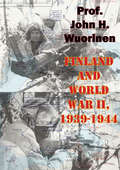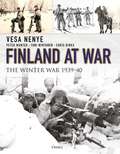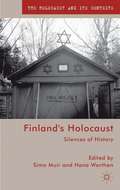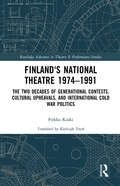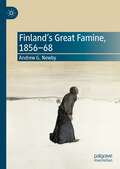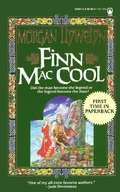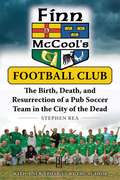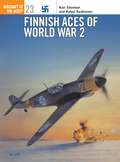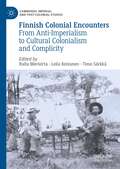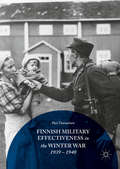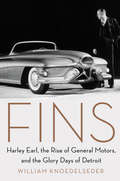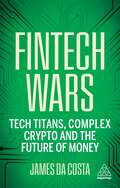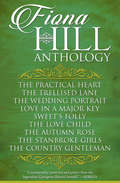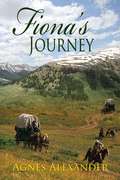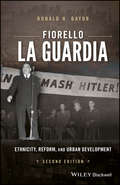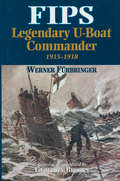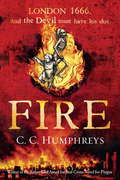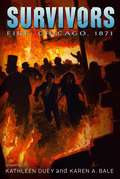- Table View
- List View
Finishing in Architecture: Polishing, Completing, Ending
by Paul Emmons Marcia Feuerstein Negar Goljan Camila MancillaFinishing in Architecture: Polishing, Completing, Ending explores the topic of finishing and the fascinating physical and metaphysical implications of its various conceptions in architecture. Finishing is essential to all human practices and concepts of time, yet simultaneously it is largely impossible to identify an entirely finished state of being. As mortals, we organize our worlds into beginnings and endings, starts and finishes. Architecture’s temporality, however, may contain something of both the mortal and immortal within it – a desire for permanence combined with lamentation over its impossibility.While many approaches to finishing construct two opposed ontological conditions (the finished and the unfinished), this dualistic ploy neglects the complexity of architectural practice, cultural reception, and historiographic shifts in semiotics during the lifetime of a building. More nuanced approaches are examined in this collection of 38 essays and creative works from a diverse group of scholars, architects, and artists who conceptualize finishing not simply as a final outcome, but as an extended action, a mood that presumes an end is near, all the while working continuously toward (but never achieving) completion. It is here that the concept of finishing is not a state of being but a state of becoming, as an active thickening of time when the end is thought to be imminent but not yet attained. Finishing, more than a final endpoint, is a void state that is extended through efforts framing its territory, while never quite containing it.From the material to the procedural and the conceptual, this volume explores the practices of finishing in architecture within three currents: surfaces, projects, and most broadly, architectural times. It will be of interest to students and instructors of architecture and design, architectural historians, and other scholars.
Finisterre: Novela
by María Rosa LojoDurante el invierno londinense de 1874, la joven Elizabeth Armstrongrecibe la primera carta de Rosalind desde Finisterre, el cabo del findel mundo, en la Galicia española. La joven Elizabeth Armstrong, única hija de un hombre de negocios, viudoy adinerado, recibe la primera carta de Rosalind, que promete romper elobstinado silencio con que el señor Armstrong ha rodeado siempre elnacimiento de su hija en el Río de la Plata. Sus cartas se remontancuarenta años atrás, hasta el camino de Buenos Aires a Córdoba que haunido las vidas de Rosalind, de Oliver Armstrong, de la actriz españoladoña Ana de Cáceres y de Manuel Baigorria, militar untario exiliadoentre los indios ranqueles que los toma prisioneros. Allí Rosalindpierde a su marido y también al niño que espera. Pero inicia su propio"camino de Finisterre", metáfora, si las hay, del límite y el extremodonde nos enfrentamos a lo desconocido y aterrador dentro de nosotrosmismos. Idéntico camino que Elizabeth, su fascinada lectora, comienza adesandar hacia su propio origen.
Finland And World War II, 1939-1944
by Prof. John H. WuorinenFinland gained its independence from Russia in 1917 during the turmoil of the Russian Civil War, and ever since the communist leaders cast envious eyes toward their former domain; only waiting for a chance to invade. With the rise of Hitler's Germany the face of Europe changed, agreements were reached between the Soviets and the Nazis in brutally dividing up a nigh-defenceless and the detente culminated in the Non-Aggression Pact of 1939. This gave Stalin and his cohorts a chance to expand their borders, whilst Hitler looked west at France and Britain, by launching an attack directed to recapture their former Grand Duchy. Thus started Finland's participation in the Second World War. This book eloquently recounts the stubborn resistance of the Finns against the Soviet attack during the Winter War, the horrific siege of Leningrad and the Finns brave bid to retain its independence from Soviet dominance. The manuscript for the book was smuggled out of Soviet controlled Finland in late 1945, it was passed to Professor Wuorinen who skilfully edited and annotated the work into its present form.A fascinating sidelight on a little known corner of the brutal Second World War.
Finland at War 1939-45
by Raffaele Ruggeri Philip JowettIn the face of Soviet invasion in 1939-40, and once again in 1941-44, the armies raised by Finland - a tiny nation of only 4 million people - astonished the world by their effective resistance. At the end of both these campaigns - the Winter War, and the Continuation War - the fiercely patriotic defiance of vastly stronger Soviet forces by Marshal Mannerheim's soldiers won their country a unique prize: although forced to accept harsh terms, Finland was never occupied by the Red Army, and retained its independence. This book explains and illustrates, for the first time in English, the organization, uniforms, equipment and tactics of Finland's defenders.
Finland at War: The Winter War 1939-40
by Vesa NenyeThe story of the 'Winter War' between Finland and Soviet Russia is a dramatic David versus Goliath encounter. When close to half a million Soviet troops poured into Finland in 1939 it was expected that Finnish defences would collapse in a matter of weeks. But they held firm. The Finns not only survived the initial attacks but succeeded in inflicting devastating casualties before superior Russian numbers eventually forced a peace settlement. This is a rigorously detailed and utterly compelling guide to Finland's vital, but almost forgotten role in the cataclysmic World War II. It reveals the untold story of iron determination, unparalleled skill and utter mastery of winter warfare that characterized Finland's fight for survival on the hellish Eastern Front. Finland at War: the Winter War 1939-40 is the premiere English-language history of the fighting performance of the Finns, drawing on first-hand accounts and previously unpublished photographs to explain just how they were able to perform military feats that nearly defy belief.
Finland's Holocaust
by Simo Muir Hana WorthenFinland's Holocaust considers antisemitism and the figure of the Holocaust in today's Finland. Taking up a range of issues - from cultural history, folklore, and sports, to the interpretation of military and national history - this collection examines how the writing of history has engaged and evaded the figure of the Holocaust.
Finland's National Theatre 1974–1991: The Two Decades of Generational Contests, Cultural Upheavals, and International Cold War Politics (Routledge Advances in Theatre & Performance Studies)
by Pirkko KoskiThis study analyses the Finnish National Theatre’s activities throughout the decades during which the post-war generation with its new societal and theatrical views was rising to power, and during which Europe, divided by the Iron Curtain, was maturing to break the boundaries dividing it. Pirkko Koski summarizes the activities of the Finnish National Theatre as a cultural factor and as a part of the Finnish theatre field during 1970s and 1980s. Alongside this he examines the general requirements, resources and structures for activity, including artists, places, geographical position, performances and the analysis on the societal conditions. This book will be of great interest to scholars and students of European theatre and history.
Finland’s Great Famine, 1856-68
by Andrew G. NewbyThis book will provide a thematic overview of one of European history’s most devastating famines, the Great Finnish Famine of the 1860s. In 1868, the nadir of several years of worsening economic conditions, 137,000 people (approximately 8% of the Finnish population) perished as the result of hunger and disease. The attitudes and policies enacted by Finland’s devolved administration tended to follow European norms, and therefore were often similar to the “colonial” practices seen in other famines at the time. What is distinctive about this catastrophe in a mid-nineteenth-century context, is that despite Finland being a part of the Russian Empire, it was largely responsible for its own governance, and indeed was developing its economic, political and cultural autonomy at the time of the famine. Finland’s Great Famine 1856-68 examines key themes such as the use of emergency foods, domestic and overseas charity, vagrancy and crime, emergency relief works, and emigration.
Finley Ball: How Two Baseball Outsiders Turned the Oakland A's into a Dynasty and Changed the Game Forever
by Nancy FinleyThis is the story of a losing baseball team that became a 1970s dynasty, thanks to the unorthodox strategies and stunts of two very colorful men. <P><P>When Charlie Finley bought the A's in 1960, he was an outsider to the game-a insurance businessman with a larger-than-life personality. He brought his cousin Carl on as his right-hand man, moved the team from Kansas City to Oakland, and pioneered a new way to put together a winning team. With legendary players like Reggie Jackson, Catfish Hunter, and Vida Blue, the Finleys' Oakland A's won three straight World Series and riveted the nation. <P><P>Now Carl Finley's daughter Nancy reveals the whole story behind her family's winning legacy-how her father and uncle developed their scouting strategy, why they employed odd gimmicks like orange baseballs and "mustache bonuses," and how the success of the '70s Oakland A's changed the game of baseball.
Finn Mac Cool
by Morgan LlywelynSomewhere in the shadowy borderland between myth and history lies the territory of Finn Mac Cool, Mightiest of the Irish heroes, leader of the invincible army of Fianna, he was a man of many faces: warrior, poet, lover, creator, destroyer.
Finn McCool's Football Club: The Birth, Death, and Resurrection of a Pub Soccer Team in the City of the Dead
by Stephen ReaIn 2004, Belfast-born Stephen Rea moved to New Orleans, a city where "football" means something entirely different than what it does back home. After struggling to find a place to watch European soccer games, Rea discovered Finn McCool's pub and its mixed clientele of good-humored European ex-pats, charismatic New Orleanians, and assorted matchless personalities. Before long he was playing on the pub's motley over-thirty-five fledgling soccer team. Gathered at the bar on August 27, 2005, members of the team were discussing their upcoming match, untroubled by the impending storm and unknowing that their city and team would nearly be obliterated by Hurricane Katrina in a matter of hours. Days later, the lucky among them were scattered across the country; the others struggled to survive as they awaited rescue in New Orleans. With clarity and compassion, Rea examines the disaster as he profiles the experiences of his teammates and their efforts to resurrect the team and pub that had become so central in all of their lives. A gripping and moving memoir about an unusual pub team and a devastating natural disaster, Finn McCool’s Football Club is a celebration of ex-pats and pubs, soccer and sportsmanship, and the strength it takes to rebuild a team, a city, and a life.
Finnish Aces of World War 2
by Kari StenmanAlways outnumbered by their Soviet counterparts, the small band of Finnish fighter pilots who defended their Scandinavian homeland from the 'communist hordes' in three separate wars between 1939 and 1945 amassed scores only bettered by the Luftwaffe's Jagdflieger. Initially equipped with a motley collection of biplane and monoplane fighters garnered from sources across the globe, the Finnish Air Force was thrust into combat in November 1939. Given little chance against the massive Soviet force, the Finnish fighter pilots confounded the sceptics and decimated the attacking fighter and bomber formations, prompting the Russians to call a halt in March 1940. This scenario was repeated in 1941, and by 1943 the Finns had become uneasy allies with the Germans. Complete with first-hand accounts and detailed colour illustrations, this book profiles aces like Juutilainen and Wind, who proved unbeatable in the final months of conflict.
Finnish Colonial Encounters: From Anti-Imperialism to Cultural Colonialism and Complicity (Cambridge Imperial and Post-Colonial Studies)
by Timo Särkkä Raita Merivirta Leila KoivunenBreaking new ground in the study of European colonialism, this book focuses on a nation historically positioned between the Western and Eastern Empires of Europe – Finland. Although Finland never had overseas colonies, the authors argue that the country was undeniably involved in the colonial world, with Finns adopting ideologies and identities that cannot easily be disentangled from colonialism. This book explores the concepts of ‘colonial complicity’ and ‘colonialism without colonies’ in relation to Finland, a nation that was oppressed, but also itself complicit in colonialism. It offers insights into European colonialism on the margins of the continent and within a nation that has traditionally declared its innocence and exceptionalism. The book shows that Finns were active participants in various colonial contexts, including Southern Africa and Sápmi in the North. Demonstrating that colonialism was a common practice shared by all European nations, with or without formal colonies, this book provides essential reading for anyone interested in European colonial history.Chapters 1, 7 and 8 are available open access under a via link.springer.com.>
Finnish Military Effectiveness in the Winter War, 1939-1940
by Pasi TuunainenThis book analyzes the multi-faceted phenomenon of Finnish military effectiveness in the Winter War (1939-40). Drawing on a wide array of primary and secondary sources, Pasi Tuunainen shows how by focusing on their own strengths and pitting these against the weaknesses of their adversary, the Finns were able to inflict heavy casualties on the Red Army whilst minimizing their own losses. The Finns were able to use their resources for effective operational purposes, and perform almost to their full potential. The Finnish small-unit tactics utilized the terrain and Arctic conditions for which they had prepared themselves, as well as forming cohesive units of well-motivated and qualitatively better professional leaders and citizen soldiers who could innovate and adapt. The Finnish Army had highly effective logistics, support and supply systems that kept the troops fighting.
Fins: Harley Earl, the Rise of General Motors, and the Glory Days of Detroit
by William KnoedelsederThe New York Times bestselling author of Bitter Brew chronicles the birth and rise to greatness of the American auto industry through the remarkable life of Harley Earl, an eccentric six-foot-five, stuttering visionary who dropped out of college and went on to invent the profession of automobile styling, thereby revolutionized the way cars were made, marketed, and even imagined.Harleys Earl’s story qualifies as a bona fide American family saga. It began in the Michigan pine forest in the years after the Civil War, traveled across the Great Plains on the wooden wheels of a covered wagon, and eventually settled in a dirt road village named Hollywood, California, where young Harley took the skills he learned working in his father’s carriage shop and applied them to designing sleek, racy-looking automobile bodies for the fast crowd in the burgeoning silent movie business.As the 1920s roared with the sound of mass manufacturing, Harley returned to Michigan, where, at GM’s invitation, he introduced art into the rigid mechanics of auto-making. Over the next thirty years, he functioned as a kind of combination Steve Jobs and Tom Ford of his time, redefining the form and function of the country’s premier product. His impact was profound. When he retired as GM’s VP of Styling in 1958, Detroit reigned as the manufacturing capitol of the world and General Motors ranked as the most successful company in the history of business.Knoedelseder tells the story in ways both large and small, weaving the history of the company with the history of Detroit and the Earl family as Fins examines the effect of the automobile on America’s economy, culture, and national psyche.
Fintech Wars: Tech Titans, Complex Crypto and the Future of Money
by James da CostaFintech touches every part of our lives, from cashless economies to crypto, and even our climate. This book draws back the curtain on this fascinating world full of friction, failure and fortune.Fintech Wars delves into one of the world's most lucrative and fast-growing sectors. Witness the bold strategies, groundbreaking innovations, and relentless drive that propelled fintech unicorns like PayPal, Nubank and Monzo to transform the world. Featuring interviews with generational founders including Reid Hoffman (LinkedIn), Nigel Morris (Capital One), and Martha Lane Fox (Lastminute.com), the narrators of this book have built companies that represent over one trillion dollars in market capitalization.As the founder of a digital bank, James da Costa is a fintech insider. He draws upon his network and first-hand experiences to offer a fascinating look into the intricacies and motivations behind building billion-dollar disruptors. Step into the fascinating, unpredictable and inspiring world of fintech.
Fiona Hill Anthology
by Fiona HillA sparkling collection of Regency romances from the popular author with &“considerably more wit and pizazz than the legendary Georgette [Heyer] herself&” (Kirkus Reviews). A true artist of Regency romance, Fiona Hill paints pictures of the past with warmth and charm, enchanting readers the world over with her beautiful, heartfelt tales. Ladies and lords, viscounts and estates, Fiona Hill weaves spellbinding stories that bring readers back in time and set them in the middle of household intrigue, of passion and peril, of complicated men and independent women. In these nine tour-de-force novels, Hill takes her readers on a journey to a bygone era, into the beating heart of Regency-era England, where trouble is always afoot—and so is new love . . .Praise for the novels of Fiona Hill&“In the battle of the sexes waged in this lively Regency romance, the contestants are overtaken by circumstances . . . The victory is detailed with wit and verve.&”—Publishers Weekly on The Country Gentleman &“[A] very un-fusty Regency frolic, this one featuring a quartet of nicely matched pairs . . . another little winner.&”—Kirkus Reviews on The Stanbroke Girls
Fiona's Journey
by Agnes AlexanderIn March, 1855, Fiona Webb ran from her home with her eight-year-old nephew, Joey, after her brother and sister-in-law are murdered. They are trying to escape a brutal neighbor, Luther Markin, who plans to make a slave of Joey and use Fiona for his own evil purposes. To get on a wagon train heading for Oregon they join Clint Larson and his pregnant wife, Rose as extended family. It doesn't take Fiona long to realize she's attracted to Clint despite her feelings of sisterly love for Rose. To complicate things, Luther Markin teams up with Rose's father, Wade Fillmore and his business partner, Leo Carver from Baltimore and they follow the wagon train. Fillmore wants to take Rose away from Larson and force her to go back east, but Carver has his own depraved reason for wanting to find Rose.
Fiorello La Guardia: Ethnicity, Reform, and Urban Development
by Ronald H. BayorFiorello La Guardia was an ambitious man who wanted great success for himself—but he also wanted to advocate on behalf of the poor and forgotten. Through hard work and perseverance he managed to achieve both. This work examines the life of the man who not only became one of New York’s greatest and most renowned mayors, but who brought about some of the most important changes in the history of the city. This thoroughly revised second edition of Fiorello La Guardia: Ethnicity, Reform, and Urban Development looks at the many events of the popular mayor’s life—his early beginnings as a politician, the events surrounding his life and city, his multiple terms as New York City’s Mayor, his personal and professional disappointments, and his ultimate place in history. It also examines the broader subject of cities during times of stress, the ability of mayors to enhance urban life, and the origins of federal aid to cities. Connects the New York and urban story to that of the nation and to the subfields of Progressivism, the Depression, the New Deal, and World War II Contains 16 new images—of La Guardia, his contemporaries, and city shots—spaced throughout the text Offers a timeline of principal dates in La Guardia’s life keyed to significant events in the city’s, state’s, and nation’s history Includes key terms and study questions for each chapter Features a completely updated bibliographical essay Comprehensive, yet highly accessible, Fiorello La Guardia: Ethnicity, Reform, and Urban Development, Second Edition makes ideal supplementary reading for survey courses in the history of New York or New York City as well as for general American History courses.
Fios de Seda
by Amanda RobertsFios de seda por Amanda Roberts Do leito de um imperador, ao coração de um príncipe, e ao lado direito de uma imperatriz, Yaqian abre caminho pelas décadas mais turbulentas da história da China e testemunha a queda da dinastia Qing. Quando eu era criança, achava que o meu destino era viver e morrer nas margens do rio Xiangjiang, como minha família havia feito por gerações. Nunca imaginei que a minha vida me levaria à Cidade Proibida e à corte da última imperatriz da China. Nascida no meio do nada, Yaqian, uma garotinha bordadeira da província de Hunan, encontra o caminho para a corte imperial, um local de intrigas, desejos e traições. Do leito de um imperador, ao coração de um príncipe, e ao lado direito de uma imperatriz, Yaqian abre caminho pelas décadas mais turbulentas da história da China e testemunha a queda da dinastia Qing. Os fãs de Amy Tan, Lisa See, Anchee Min e Pearl S. Buck vão adorar este romance de estréia de Amanda Roberts. Esta novela ricamente descritiva e, meticulosamente pesquisada, dá vida à opulência da Corte Qing, à medida que as vidas de Yaqian e da Imperatriz Cixi se entrelaçam ao longo de seis décadas. Gênero: FICÇÃO / Patrimônio Cultural Secundário Gênero: FICÇÃO / Histórica Idioma: Inglês Palavras-chave: ficção histórica, chinês, China, romance, dinastia qing Contagem de palavra: 100.000 Informações sobre vendas: Venda intensa, mais de 500 cópias por mês por quase 2 anos após o lançamento. No seu auge, vendeu mais de 1.000 cópias por mês durante vários meses. Tem sido consistentemente classificado, entre as 10 melhores obras de ficção chinesa histórica, desde o seu lançamento e, frequentemente, aparece nas categorias de ficção cultural e biográfica. <br
Fips: Legendary U-Boat Commander, 1915–1918
by Geoffrey Brooks Werner FürbringerWeuner Frbringer (Fips) became one of the most successful U-Boat commanders in WW1 through a blend of skill, daring and, by his own typically modest admission, sheer luck. This vivid memoir, never before published in English, makes compelling reading.This is an inspiring and chivalrous story; it is ironic then that, when finally sunk by the Royal Navy off the East Coast of England, Fips was machine-gunned in the water, contrary to repeated Government denials of such behaviour.
Fir Island and Conway (Images of America)
by Andrea Millward Xaver Janet K. Utgard Patricia Hanstad PleasThe North Fork and the South Fork of the Skagit River were navigated by those searching for gold and land in the 1870s. Flooding became a deterrent for many, but those who stayed discovered an abundance of fertile soil and natural resources. Scandinavian immigrants, predominantly Norwegian, came to settle in the area, some with their families, and worked in logging and in farming. As the population grew, small towns and businesses were soon established. Skagit City and Fir were located on Fir Island; Conway and Milltown were located east of the island. In 1914, a bridge connected the island to the mainland, replacing the ferry at Mann’s Landing. After many floods, the removal of logjams, and the arrival of the Great Northern Railroad, Mount Vernon began to prosper upriver, and the little towns began to disappear. Today, Fir Island and Conway are destinations for tourists who come to see snow geese and trumpeter swans during migration. Farmers continue to work the soil, and many descendants of pioneers still remain.
Fircrest
by Ralph R. ColyerFircrest was ready and waiting when America exploded into the modern era following World War II. In 1906, the creative energy of Edward "Major" Bowes, of Amateur Hour fame, combined with the engineering brilliance of Mat R. Thompson to create the quintessential American suburb. Anticipating America's love affair with the automobile, they designed a modern "suburban park" with wide streets that curved with the contours of the land. Brisk initial sales faded, and the development, Regents Park, struggled. But the people of "the Park" persevered. In 1925, the Fircrest Golf Club was started, and the homeowners joined together to incorporate. Seeking a fresh start, they renamed their village the City of Fircrest. Postwar homebuilders discovered a solid community with a modern plan and available shovel-ready lots. When the dust settled, the iconic midcentury American neighborhood that Bowes and Thompson envisioned stood proud.
Fire
by C. C. HumphreysFirst came Plague, now comes Fire. The epic tale of the hunt for a serial killer threatening London's rich and poor during the Great Fire of London. Perfect for fans of C.J. Sansom and Conn Iggulden.Fires don't start by themselves. They need someone to light them. What are friends for? As the Great Plague of London loosens its grip at last, Charles II's court moves back to the city, the theatres reopen and a new year arrives. 1666. It cannot be more terrible than the previous year, surely? But it can. For many will strive to make it so; to finally rid London of the curse that brought the plague upon it. A wholesale cleansing is required if society is to be born again. What's more it seems that a serial killer who stalked hand in hand with the Plague might not be dead after all. Together with actress Sarah Chalker, highwayman William Coke and thief-taker Pitman come together as one, determined to stop the brutal murder of London's rich and poor once and for all. But another threat is on the way. It hasn't rained in five months. London is a tinderbox--politically, sexually and religiously. The Great Fire of London is about to ignite. And the final confrontation between Coke, Pitman and Sarah Chalker and their murderous adversary will be decided against a background of apocalypse.
Fire
by Kathleen Duey Karen A. BaleCan two kids survive the flames of the great Chicago Fire of 1871? Find out in this riveting historical fiction, part of the Survivor series.Nate Copper and his best friend Ryan love to sneak out at night to watch firefighters battle the blazes that have plagued Chicago all through the dry, windy summer of 1871. Wealthy Julie Flynn, suffocated by her overprotective parents, can't imagine adventures like Nate's--and he's definitely not a boy she would ever be friends with. But fate and fire throw Nate and Julie together on the dark and dangerous streets of Chicago, and in the chaos of the crowds, Julie is kidnapped. Nate has to try to figure out a way to free her before the wind-driven flames spreading across the city cut off their only chance of escape. Will Nate and Julie be able to survive?


